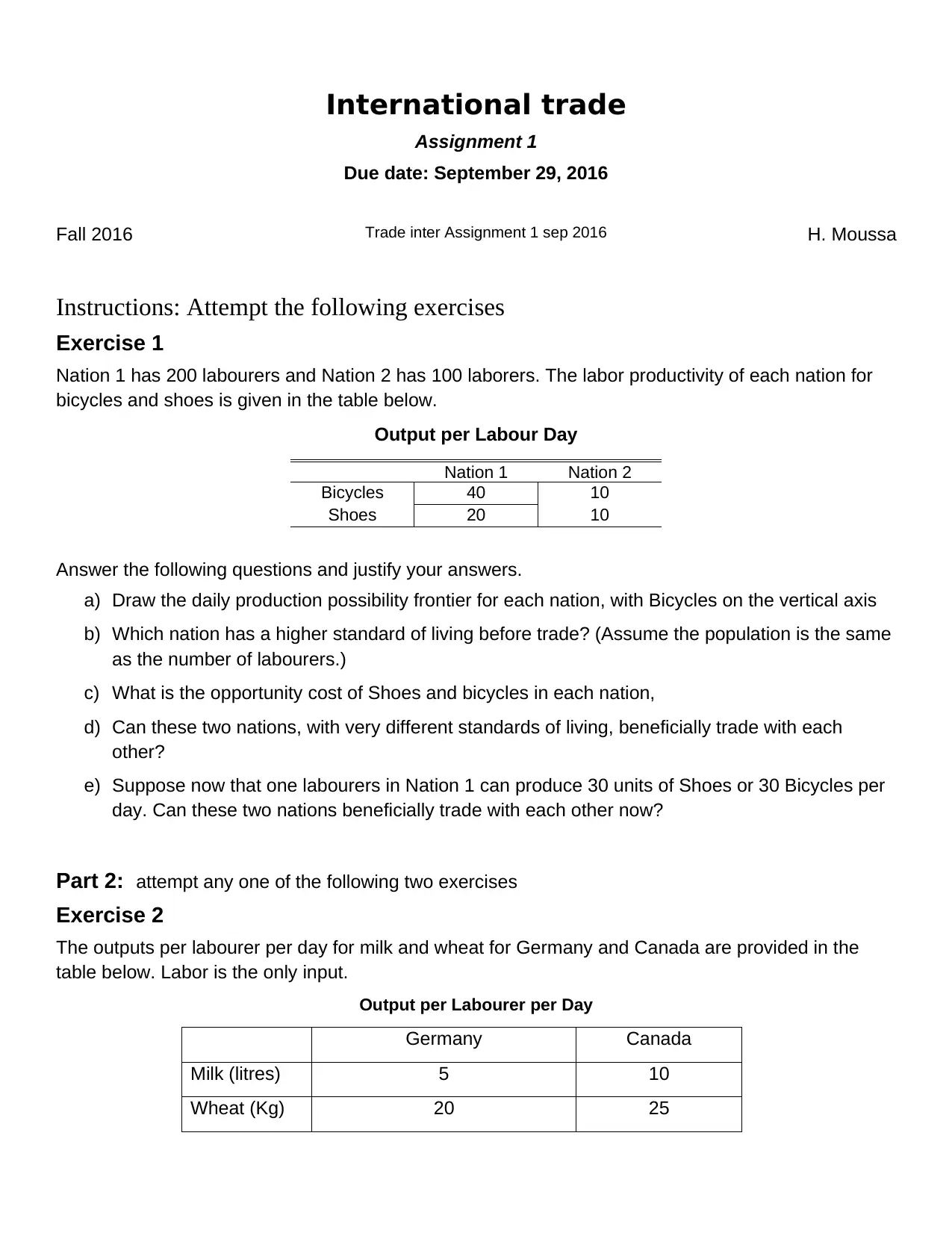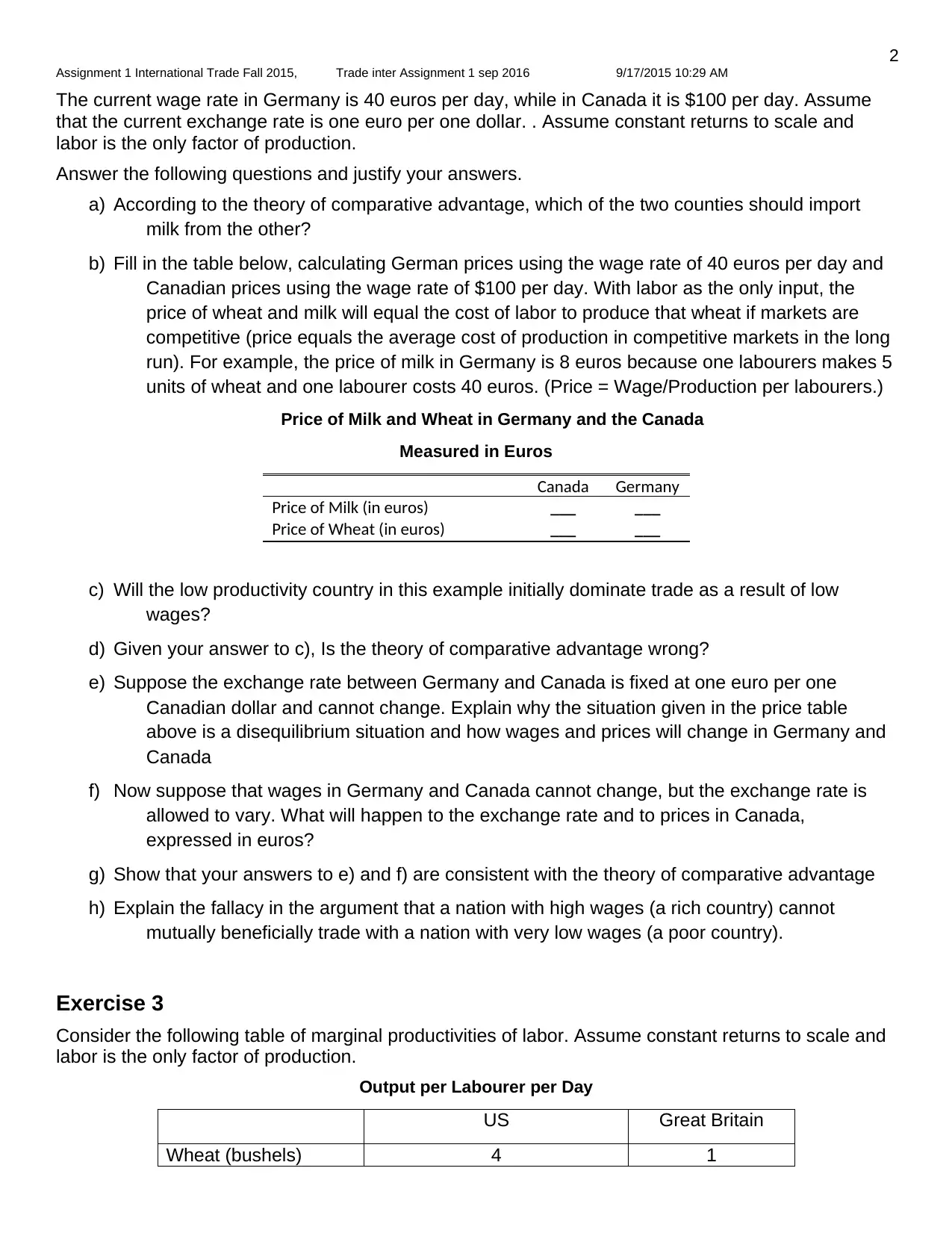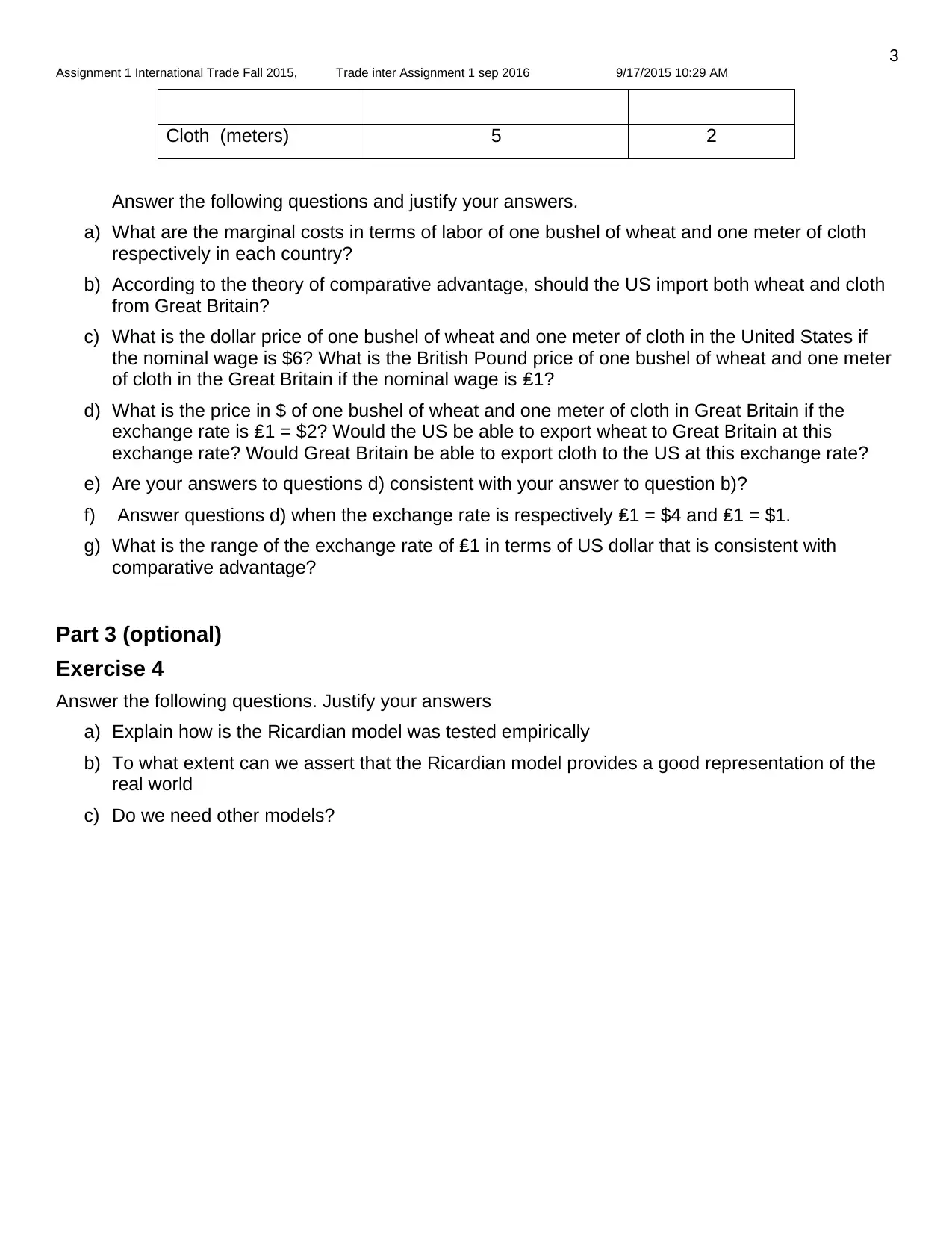International Trade
VerifiedAdded on 2019/09/23
|3
|1023
|228
Homework Assignment
AI Summary
The assignment content is about international trade, specifically exploring the concept of comparative advantage. The exercises involve calculating production possibility frontiers, opportunity costs, and prices for different nations. Students are asked to analyze whether two nations can beneficially trade with each other based on their labor productivities and wage rates. Additionally, the assignment discusses the theory of comparative advantage, its limitations, and the need for other models in understanding international trade.
Contribute Materials
Your contribution can guide someone’s learning journey. Share your
documents today.

International trade
Assignment 1
Due date: September 29, 2016
Fall 2016 Trade inter Assignment 1 sep 2016 H. Moussa
Instructions: Attempt the following exercises
Exercise 1
Nation 1 has 200 labourers and Nation 2 has 100 laborers. The labor productivity of each nation for
bicycles and shoes is given in the table below.
Output per Labour Day
Answer the following questions and justify your answers.
a) Draw the daily production possibility frontier for each nation, with Bicycles on the vertical axis
b) Which nation has a higher standard of living before trade? (Assume the population is the same
as the number of labourers.)
c) What is the opportunity cost of Shoes and bicycles in each nation,
d) Can these two nations, with very different standards of living, beneficially trade with each
other?
e) Suppose now that one labourers in Nation 1 can produce 30 units of Shoes or 30 Bicycles per
day. Can these two nations beneficially trade with each other now?
Part 2: attempt any one of the following two exercises
Exercise 2
The outputs per labourer per day for milk and wheat for Germany and Canada are provided in the
table below. Labor is the only input.
Output per Labourer per Day
Germany Canada
Milk (litres) 5 10
Wheat (Kg) 20 25
Nation 1 Nation 2
Bicycles 40 10
Shoes 20 10
Assignment 1
Due date: September 29, 2016
Fall 2016 Trade inter Assignment 1 sep 2016 H. Moussa
Instructions: Attempt the following exercises
Exercise 1
Nation 1 has 200 labourers and Nation 2 has 100 laborers. The labor productivity of each nation for
bicycles and shoes is given in the table below.
Output per Labour Day
Answer the following questions and justify your answers.
a) Draw the daily production possibility frontier for each nation, with Bicycles on the vertical axis
b) Which nation has a higher standard of living before trade? (Assume the population is the same
as the number of labourers.)
c) What is the opportunity cost of Shoes and bicycles in each nation,
d) Can these two nations, with very different standards of living, beneficially trade with each
other?
e) Suppose now that one labourers in Nation 1 can produce 30 units of Shoes or 30 Bicycles per
day. Can these two nations beneficially trade with each other now?
Part 2: attempt any one of the following two exercises
Exercise 2
The outputs per labourer per day for milk and wheat for Germany and Canada are provided in the
table below. Labor is the only input.
Output per Labourer per Day
Germany Canada
Milk (litres) 5 10
Wheat (Kg) 20 25
Nation 1 Nation 2
Bicycles 40 10
Shoes 20 10
Secure Best Marks with AI Grader
Need help grading? Try our AI Grader for instant feedback on your assignments.

Assignment 1 International Trade Fall 2015, Trade inter Assignment 1 sep 2016 9/17/2015 10:29 AM
The current wage rate in Germany is 40 euros per day, while in Canada it is $100 per day. Assume
that the current exchange rate is one euro per one dollar. . Assume constant returns to scale and
labor is the only factor of production.
Answer the following questions and justify your answers.
a) According to the theory of comparative advantage, which of the two counties should import
milk from the other?
b) Fill in the table below, calculating German prices using the wage rate of 40 euros per day and
Canadian prices using the wage rate of $100 per day. With labor as the only input, the
price of wheat and milk will equal the cost of labor to produce that wheat if markets are
competitive (price equals the average cost of production in competitive markets in the long
run). For example, the price of milk in Germany is 8 euros because one labourers makes 5
units of wheat and one labourer costs 40 euros. (Price = Wage/Production per labourers.)
Price of Milk and Wheat in Germany and the Canada
Measured in Euros
c) Will the low productivity country in this example initially dominate trade as a result of low
wages?
d) Given your answer to c), Is the theory of comparative advantage wrong?
e) Suppose the exchange rate between Germany and Canada is fixed at one euro per one
Canadian dollar and cannot change. Explain why the situation given in the price table
above is a disequilibrium situation and how wages and prices will change in Germany and
Canada
f) Now suppose that wages in Germany and Canada cannot change, but the exchange rate is
allowed to vary. What will happen to the exchange rate and to prices in Canada,
expressed in euros?
g) Show that your answers to e) and f) are consistent with the theory of comparative advantage
h) Explain the fallacy in the argument that a nation with high wages (a rich country) cannot
mutually beneficially trade with a nation with very low wages (a poor country).
Exercise 3
Consider the following table of marginal productivities of labor. Assume constant returns to scale and
labor is the only factor of production.
Output per Labourer per Day
US Great Britain
Wheat (bushels) 4 1
Canada Germany
Price of Milk (in euros) ___ ___
Price of Wheat (in euros) ___ ___
2
The current wage rate in Germany is 40 euros per day, while in Canada it is $100 per day. Assume
that the current exchange rate is one euro per one dollar. . Assume constant returns to scale and
labor is the only factor of production.
Answer the following questions and justify your answers.
a) According to the theory of comparative advantage, which of the two counties should import
milk from the other?
b) Fill in the table below, calculating German prices using the wage rate of 40 euros per day and
Canadian prices using the wage rate of $100 per day. With labor as the only input, the
price of wheat and milk will equal the cost of labor to produce that wheat if markets are
competitive (price equals the average cost of production in competitive markets in the long
run). For example, the price of milk in Germany is 8 euros because one labourers makes 5
units of wheat and one labourer costs 40 euros. (Price = Wage/Production per labourers.)
Price of Milk and Wheat in Germany and the Canada
Measured in Euros
c) Will the low productivity country in this example initially dominate trade as a result of low
wages?
d) Given your answer to c), Is the theory of comparative advantage wrong?
e) Suppose the exchange rate between Germany and Canada is fixed at one euro per one
Canadian dollar and cannot change. Explain why the situation given in the price table
above is a disequilibrium situation and how wages and prices will change in Germany and
Canada
f) Now suppose that wages in Germany and Canada cannot change, but the exchange rate is
allowed to vary. What will happen to the exchange rate and to prices in Canada,
expressed in euros?
g) Show that your answers to e) and f) are consistent with the theory of comparative advantage
h) Explain the fallacy in the argument that a nation with high wages (a rich country) cannot
mutually beneficially trade with a nation with very low wages (a poor country).
Exercise 3
Consider the following table of marginal productivities of labor. Assume constant returns to scale and
labor is the only factor of production.
Output per Labourer per Day
US Great Britain
Wheat (bushels) 4 1
Canada Germany
Price of Milk (in euros) ___ ___
Price of Wheat (in euros) ___ ___
2

Assignment 1 International Trade Fall 2015, Trade inter Assignment 1 sep 2016 9/17/2015 10:29 AM
Cloth (meters) 5 2
Answer the following questions and justify your answers.
a) What are the marginal costs in terms of labor of one bushel of wheat and one meter of cloth
respectively in each country?
b) According to the theory of comparative advantage, should the US import both wheat and cloth
from Great Britain?
c) What is the dollar price of one bushel of wheat and one meter of cloth in the United States if
the nominal wage is $6? What is the British Pound price of one bushel of wheat and one meter
of cloth in the Great Britain if the nominal wage is ₤1?
d) What is the price in $ of one bushel of wheat and one meter of cloth in Great Britain if the
exchange rate is ₤1 = $2? Would the US be able to export wheat to Great Britain at this
exchange rate? Would Great Britain be able to export cloth to the US at this exchange rate?
e) Are your answers to questions d) consistent with your answer to question b)?
f) Answer questions d) when the exchange rate is respectively ₤1 = $4 and ₤1 = $1.
g) What is the range of the exchange rate of ₤1 in terms of US dollar that is consistent with
comparative advantage?
Part 3 (optional)
Exercise 4
Answer the following questions. Justify your answers
a) Explain how is the Ricardian model was tested empirically
b) To what extent can we assert that the Ricardian model provides a good representation of the
real world
c) Do we need other models?
3
Cloth (meters) 5 2
Answer the following questions and justify your answers.
a) What are the marginal costs in terms of labor of one bushel of wheat and one meter of cloth
respectively in each country?
b) According to the theory of comparative advantage, should the US import both wheat and cloth
from Great Britain?
c) What is the dollar price of one bushel of wheat and one meter of cloth in the United States if
the nominal wage is $6? What is the British Pound price of one bushel of wheat and one meter
of cloth in the Great Britain if the nominal wage is ₤1?
d) What is the price in $ of one bushel of wheat and one meter of cloth in Great Britain if the
exchange rate is ₤1 = $2? Would the US be able to export wheat to Great Britain at this
exchange rate? Would Great Britain be able to export cloth to the US at this exchange rate?
e) Are your answers to questions d) consistent with your answer to question b)?
f) Answer questions d) when the exchange rate is respectively ₤1 = $4 and ₤1 = $1.
g) What is the range of the exchange rate of ₤1 in terms of US dollar that is consistent with
comparative advantage?
Part 3 (optional)
Exercise 4
Answer the following questions. Justify your answers
a) Explain how is the Ricardian model was tested empirically
b) To what extent can we assert that the Ricardian model provides a good representation of the
real world
c) Do we need other models?
3
1 out of 3
![[object Object]](/_next/static/media/star-bottom.7253800d.svg)
